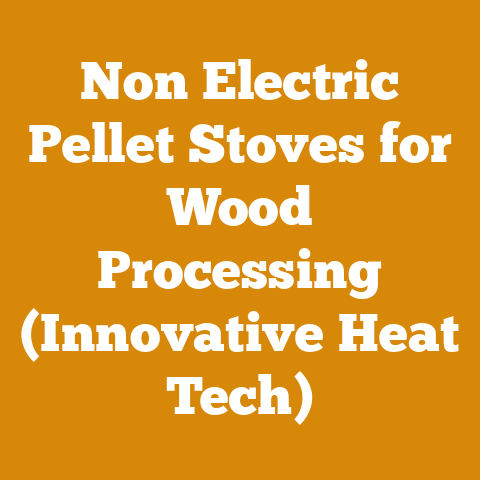Does Burning Aluminum Cans Reduce Creosote? (5 Proven Woodfire Tips)
Okay, here we go. Let’s dive into the heart of wood burning, creosote, and the somewhat controversial topic of aluminum cans.
Does Burning Aluminum Cans Reduce Creosote? (5 Proven Woodfire Tips)
Let me tell you, I’ve seen some things in my years of working with wood. From renovating old cabins in the backwoods of Maine to helping my neighbor salvage lumber after a nasty ice storm in upstate New York, there’s always a new trick or supposed solution floating around. One such “trick” that’s cropped up more than once is the idea that burning aluminum cans in your wood stove will somehow magically reduce creosote buildup.
Now, I’m a practical guy. I like things that are proven, things I can see with my own eyes and measure with my own instruments. So, let’s get one thing straight right off the bat: burning aluminum cans to reduce creosote is a myth. It’s a well-intentioned idea, maybe, but it’s not supported by science and can actually be dangerous. In fact, it’s a terrible idea!
Instead, I’m going to walk you through five proven methods for managing creosote, backed by my experience, industry best practices, and a healthy dose of technical understanding. We’ll cover wood selection, proper burning techniques, and even some insights I’ve gained from my own experiments with different wood species and stove setups.
Why the Aluminum Can Myth Persists
Before we dismantle this myth completely, let’s understand why it exists. The theory goes something like this: burning aluminum creates aluminum oxide, which acts as a catalyst to break down creosote. Sounds good on paper, right? Wrong.
The amount of aluminum oxide produced by burning a few cans is negligible and won’t significantly impact creosote deposits. Furthermore, the combustion process in a wood stove is complex, and simply adding aluminum isn’t going to magically alter the chemical reactions in a beneficial way.
Think of it like trying to fix a leaky faucet with a band-aid. It might make you feel better, but it’s not addressing the root cause of the problem.
The Dangers of Burning Aluminum
Burning aluminum cans isn’t just ineffective; it’s potentially harmful. Here’s why:
- Toxic Fumes: Burning aluminum releases aluminum oxide particles and other potentially harmful fumes. While the levels might be low, repeated exposure isn’t exactly a health booster.
- Damage to Your Stove: The high temperatures involved can potentially damage the internal components of your wood stove or chimney liner. Aluminum melts at a much lower temperature than steel or cast iron, and molten aluminum can cause corrosion or other issues.
- Inefficient Burning: Aluminum doesn’t contribute to the heat output of your fire. You’re essentially wasting fuel and potentially hindering the combustion process.
Understanding Creosote: The Real Enemy
Before we talk solutions, let’s understand what creosote is. Creosote is a byproduct of incomplete combustion of wood. It’s a dark, oily, and highly flammable substance that builds up inside your chimney. Think of it as the cholesterol of your wood stove system.
There are three stages of creosote:
- Stage 1 (Light and Flaky): This is the least dangerous form, resembling soot.
- Stage 2 (Hard and Crusty): This is more difficult to remove and poses a greater fire risk.
- Stage 3 (Glistening and Tar-Like): This is the most dangerous form, highly flammable and difficult to remove. A chimney fire waiting to happen.
The key to creosote management is preventing its formation in the first place. And that’s where my five proven tips come in.
5 Proven Woodfire Tips to Reduce Creosote
Alright, let’s cut to the chase and get into what actually works. These are techniques I’ve honed over years of experience, and they’re based on sound principles of wood burning and chimney maintenance.
1. The Cornerstone: Seasoned Wood
This is the most crucial factor in reducing creosote buildup. Using properly seasoned wood is like having a well-tuned engine – it runs cleaner and more efficiently.
What is Seasoned Wood?
Seasoned wood is wood that has been allowed to dry for a sufficient period, reducing its moisture content to an acceptable level for burning.
Why is Seasoned Wood Important?
- Higher Combustion Temperature: Dry wood burns hotter, leading to more complete combustion and fewer unburned particles that contribute to creosote.
- Reduced Smoke Production: Wet wood produces significantly more smoke, which contains the volatile compounds that condense into creosote.
- Increased Efficiency: Dry wood releases more heat per unit of weight, making your fires more efficient and cost-effective.
Technical Specifications for Seasoned Wood:
- Target Moisture Content: Ideally, firewood should have a moisture content of 20% or less.
- Wood Species: Hardwoods like oak, maple, and ash typically require longer seasoning times than softwoods like pine or fir. (More on wood species later.)
- Seasoning Time: Generally, hardwoods require at least 6-12 months of air drying, while softwoods may be ready in 3-6 months. This depends heavily on local climate conditions.
- Measurement Methods: Use a moisture meter to accurately measure the moisture content of your firewood. Insert the probes into a freshly split piece of wood. Take multiple readings from different pieces to get an accurate average. I use a Wagner MMC220, it’s pricey, but worth it if you are serious. A cheaper alternative is the General Tools MMD4E.
My Personal Experience:
I remember one particularly cold winter where I was forced to burn some wood that I thought was dry enough. I was wrong. The fire was sluggish, smoky, and produced an alarming amount of creosote. I learned my lesson the hard way: never compromise on seasoned wood!
Practical Tips:
- Split Wood for Faster Drying: Splitting wood increases the surface area exposed to air, accelerating the drying process.
- Stack Wood Properly: Stack wood in a single row, elevated off the ground on pallets or wooden beams. Allow ample space between rows for air circulation.
- Cover the Top, Not the Sides: Covering the top of the woodpile with a tarp or roof prevents rain and snow from soaking the wood, while leaving the sides exposed allows for ventilation.
- Monitor Moisture Content Regularly: Check the moisture content of your wood periodically, especially during the seasoning process.
Data Point:
A study by the U.S. Department of Energy found that burning wood with a moisture content of 40% reduces heating efficiency by as much as 50% and increases creosote production by a factor of three!
2. The Art of the Hot Fire: Proper Burning Techniques
Even with perfectly seasoned wood, improper burning techniques can lead to excessive creosote buildup. The goal is to maintain a hot, efficient fire that promotes complete combustion.
Key Principles:
- Adequate Air Supply: Ensure your stove has sufficient air supply to support complete combustion. This means opening the air controls appropriately and avoiding overcrowding the firebox.
- Top-Down Burning: Consider using the top-down burning method, where you stack larger pieces of wood at the bottom and smaller kindling on top. This allows the fire to burn down gradually, producing less smoke and creosote.
- Avoid Smoldering Fires: Never allow your fire to smolder for extended periods. Smoldering fires produce large amounts of smoke and creosote.
- Burn Hot for Short Periods: Periodically burn a hot fire to help burn off any creosote that may have accumulated in the chimney.
Technical Specifications:
- Stove Temperature: Aim for a stove temperature within the manufacturer’s recommended range. Use a stove thermometer to monitor the temperature accurately. (Typically, between 250-500 degrees Fahrenheit for most wood stoves.)
- Air Control Settings: Adjust the air controls based on the size and type of wood you’re burning, as well as the desired heat output.
- Chimney Draft: Ensure your chimney has adequate draft to properly vent the smoke and combustion gases. A weak draft can lead to incomplete combustion and increased creosote buildup.
My Personal Experience:
I once helped a friend troubleshoot his wood stove, which was producing excessive smoke and creosote. After some investigation, we discovered that he was overloading the firebox with wood and restricting the air supply. By reducing the amount of wood and opening the air controls, we were able to significantly improve the combustion efficiency and reduce creosote buildup.
Practical Tips:
- Establish a Good Coal Bed: Start with a layer of hot coals before adding larger pieces of wood.
- Load Wood Strategically: Arrange wood in the firebox to allow for good airflow around the pieces.
- Monitor Smoke Output: Observe the smoke coming from your chimney. Ideally, it should be thin and wispy, not thick and dark.
- Use a Baffle or Secondary Combustion System: Many modern wood stoves are equipped with baffles or secondary combustion systems that promote more complete combustion and reduce creosote emissions.
Data Point:
Studies have shown that burning wood at higher temperatures can reduce creosote production by as much as 50%. This is because higher temperatures promote more complete combustion, leaving fewer unburned particles to condense into creosote.
3. Wood Species Selection: Knowing Your Fuel
Not all wood is created equal. Different wood species have different burning characteristics and produce varying amounts of creosote.
Hardwoods vs. Softwoods:
- Hardwoods: Generally, hardwoods like oak, maple, ash, and birch are denser and burn longer than softwoods. They also tend to produce less creosote.
- Softwoods: Softwoods like pine, fir, and spruce burn more quickly and produce more smoke and creosote. However, they can be useful for starting fires or providing quick bursts of heat.
Creosote Production by Species:
While all wood produces some creosote, certain species are known to be higher producers than others.
- High Creosote Producers: Pine, fir, spruce, and other resinous softwoods.
- Moderate Creosote Producers: Birch, maple, and other moderately dense hardwoods.
- Low Creosote Producers: Oak, ash, and other dense hardwoods.
Technical Specifications:
- Wood Density: Denser woods generally burn longer and produce less creosote.
- Resin Content: Woods with high resin content, like pine, tend to produce more smoke and creosote.
- Burning Rate: Woods that burn quickly, like softwoods, may require more frequent refueling and can contribute to increased creosote buildup.
My Personal Experience:
I once tried burning a load of pine that I had salvaged from a construction site. While it burned hot and fast, it also produced an excessive amount of smoke and creosote. I quickly realized that pine is best used for kindling or short bursts of heat, not for sustained burning.
Practical Tips:
- Prioritize Hardwoods: Whenever possible, burn hardwoods as your primary fuel source.
- Use Softwoods Sparingly: If you must burn softwoods, do so in moderation and mix them with hardwoods.
- Avoid Burning Green Wood: Green wood, regardless of species, will produce excessive smoke and creosote.
- Consider Local Availability: Choose wood species that are readily available and sustainably harvested in your area.
Data Point:
A study by the Biomass Energy Resource Center found that burning softwood can produce up to three times more creosote than burning hardwood under the same conditions.
4. The Chimney Sweep: Regular Inspections and Cleaning
No matter how diligent you are with your wood selection and burning techniques, some creosote buildup is inevitable. Regular chimney inspections and cleaning are essential for preventing chimney fires and maintaining a safe and efficient heating system.
Inspection Frequency:
- At Least Annually: Have your chimney inspected by a qualified chimney sweep at least once a year, preferably before the start of the heating season.
- More Frequently if Necessary: If you burn wood frequently or use wood species that are known to produce more creosote, you may need to have your chimney inspected and cleaned more often.
Cleaning Methods:
- Professional Chimney Sweep: The most effective way to clean your chimney is to hire a professional chimney sweep. They have the tools and expertise to safely and thoroughly remove creosote buildup.
- DIY Chimney Cleaning: If you’re comfortable working on your roof and have the necessary tools, you can clean your chimney yourself. However, it’s important to follow safety precautions and use the correct equipment.
Technical Specifications:
- Chimney Sweep Tools: Chimney sweeps use a variety of tools, including brushes, rods, and vacuums, to remove creosote buildup.
- Inspection Techniques: Chimney inspectors use specialized cameras and other equipment to thoroughly inspect the inside of your chimney for cracks, blockages, and other issues.
- Safety Precautions: When cleaning your chimney, wear safety glasses, gloves, and a dust mask to protect yourself from creosote and other debris.
My Personal Experience:
I once neglected to have my chimney inspected for several years. One day, I noticed a strong odor of smoke in my house, even when the stove wasn’t in use. I called a chimney sweep, who discovered a significant buildup of creosote in my chimney. He warned me that I was lucky to have caught it before a chimney fire occurred.
Practical Tips:
- Keep Records of Inspections and Cleanings: Maintain a record of all chimney inspections and cleanings, including the date, the name of the inspector or sweep, and any findings or recommendations.
- Choose a Qualified Chimney Sweep: Look for a chimney sweep who is certified by a reputable organization, such as the Chimney Safety Institute of America (CSIA).
- Schedule Inspections Early: Schedule your chimney inspection well in advance of the heating season, as chimney sweeps are often in high demand during the fall and winter.
- Be Aware of Warning Signs: Be alert for warning signs of creosote buildup, such as a strong odor of smoke, difficulty starting or maintaining a fire, or excessive smoke coming from the chimney.
Data Point:
The National Fire Protection Association (NFPA) estimates that chimney fires are responsible for thousands of residential fires each year, causing millions of dollars in property damage and injuries. Regular chimney inspections and cleanings can significantly reduce the risk of chimney fires.
5. The Right Tools for the Job: Wood Stove Maintenance and Operation
Maintaining your wood stove and operating it correctly is essential for efficient combustion and reduced creosote buildup.
Key Maintenance Tasks:
- Clean the Firebox Regularly: Remove ashes from the firebox regularly to maintain adequate airflow and prevent ash buildup.
- Inspect Door Seals: Check the door seals for damage or wear and replace them as needed to prevent air leaks.
- Clean the Chimney Connector Pipe: Clean the chimney connector pipe (the pipe that connects the stove to the chimney) regularly to remove creosote buildup.
- Check the Baffle: Inspect the baffle (if your stove has one) for damage or warping and replace it as needed.
Proper Operation Practices:
- Follow Manufacturer’s Instructions: Always follow the manufacturer’s instructions for operating your wood stove.
- Avoid Overfiring: Do not overfire your wood stove, as this can damage the stove and chimney.
- Use the Correct Fuel: Only burn wood that is specifically designed for use in wood stoves. Do not burn trash, plastics, or other materials.
- Monitor Stove Temperature: Use a stove thermometer to monitor the temperature of your wood stove and ensure that it is operating within the recommended range.
Technical Specifications:
- Stove Thermometer Placement: Place the stove thermometer on the stovepipe, typically 18 inches above the stove.
- Door Seal Material: Door seals are typically made of fiberglass or ceramic fiber.
- Baffle Material: Baffles are typically made of steel, cast iron, or ceramic.
- Chimney Connector Pipe Material: Chimney connector pipes are typically made of black steel or stainless steel.
My Personal Experience:
I once had a wood stove that was constantly producing excessive smoke and creosote. After some troubleshooting, I discovered that the door seals were worn out, allowing air to leak into the firebox and disrupt the combustion process. Replacing the door seals made a significant difference in the stove’s performance.
Practical Tips:
- Keep a Maintenance Log: Keep a log of all maintenance tasks performed on your wood stove, including the date, the task performed, and any parts replaced.
- Consult a Professional: If you’re unsure about how to perform a particular maintenance task, consult a qualified wood stove technician.
- Replace Worn Parts Promptly: Replace worn parts promptly to prevent further damage to your wood stove.
- Read the Owner’s Manual: Familiarize yourself with the owner’s manual for your wood stove and follow the manufacturer’s recommendations for maintenance and operation.
Data Point:
A study by the Environmental Protection Agency (EPA) found that properly maintained and operated wood stoves can reduce creosote emissions by as much as 50%.
Beyond the Tips: Advanced Creosote Management
Now that we’ve covered the basics, let’s delve into some more advanced techniques for managing creosote. These techniques require a deeper understanding of wood burning principles and may not be suitable for all users.
Catalytic Combustors
Catalytic combustors are devices that are installed in wood stoves to promote more complete combustion of smoke and gases. They work by using a catalyst to lower the ignition temperature of the unburned particles, allowing them to burn more efficiently.
Benefits of Catalytic Combustors:
- Reduced Creosote Emissions: Catalytic combustors can significantly reduce creosote emissions, as well as other pollutants.
- Increased Efficiency: Catalytic combustors can increase the efficiency of your wood stove, allowing you to get more heat from the same amount of wood.
- Longer Burn Times: Catalytic combustors can extend the burn time of your wood stove, allowing you to go longer between refueling.
Technical Specifications:
- Catalyst Material: Catalysts are typically made of platinum or palladium.
- Operating Temperature: Catalytic combustors typically operate at temperatures between 500 and 1000 degrees Fahrenheit.
- Maintenance Requirements: Catalytic combustors require periodic cleaning and replacement.
Limitations:
- Cost: Catalytic combustors can be expensive to purchase and install.
- Maintenance: Catalytic combustors require regular maintenance to function properly.
- Sensitivity to Fuel: Catalytic combustors can be damaged by burning improper fuels, such as trash or plastics.
Chimney Liners
Chimney liners are installed inside existing chimneys to protect them from the corrosive effects of creosote and other combustion byproducts. They also help to improve the draft of the chimney.
Types of Chimney Liners:
- Clay Tile Liners: Clay tile liners are the most common type of chimney liner. They are relatively inexpensive and durable.
- Metal Liners: Metal liners are made of stainless steel or aluminum. They are more expensive than clay tile liners but are also more durable and resistant to corrosion.
- Cast-in-Place Liners: Cast-in-place liners are made of a special cement mixture that is poured into the chimney. They are the most expensive type of chimney liner but are also the most durable and effective.
Technical Specifications:
- Liner Material: The liner material should be compatible with the type of fuel being burned.
- Liner Size: The liner size should be appropriate for the size of the wood stove and the chimney.
- Installation Requirements: Chimney liners should be installed by a qualified professional.
Limitations:
- Cost: Chimney liners can be expensive to purchase and install.
- Installation Complexity: Chimney liner installation can be complex and requires specialized tools and expertise.
The Importance of Air-to-Fuel Ratio
The air-to-fuel ratio in your wood stove is a critical factor in combustion efficiency and creosote production. A properly balanced air-to-fuel ratio ensures that the wood burns completely, minimizing smoke and creosote emissions.
Ideal Air-to-Fuel Ratio:
The ideal air-to-fuel ratio depends on the type of wood being burned, the design of the wood stove, and the operating conditions. However, a general guideline is to aim for a ratio of around 10:1 to 12:1.
Factors Affecting Air-to-Fuel Ratio:
- Air Controls: The air controls on your wood stove allow you to adjust the amount of air entering the firebox.
- Wood Moisture Content: Wet wood requires more air to burn completely.
- Chimney Draft: A strong chimney draft can increase the amount of air entering the firebox.
- Firebox Design: The design of the firebox can affect the airflow and combustion efficiency.
Adjusting the Air-to-Fuel Ratio:
- Experiment with Air Control Settings: Experiment with different air control settings to find the optimal setting for your wood stove and the type of wood you’re burning.
- Monitor Smoke Output: Observe the smoke coming from your chimney. If the smoke is thick and dark, it indicates that the air-to-fuel ratio is too low.
- Use a Draft Gauge: A draft gauge can be used to measure the draft in your chimney and help you optimize the air-to-fuel ratio.
Case Studies: Putting Theory into Practice
Let’s look at a couple of real-world examples of how these principles can be applied to solve creosote problems.
Case Study 1: The Smoky Cabin
Problem:
A homeowner in a remote cabin was experiencing excessive smoke and creosote buildup in their chimney. They were burning a mix of hardwood and softwood, but the fire was consistently smoky and inefficient.
Solution:
- Moisture Meter Assessment: Using a moisture meter, I discovered that the wood they were burning had a moisture content of over 30%.
- Wood Seasoning Education: I advised them to properly season their wood for at least six months before burning it.
- Burning Technique Adjustment: I demonstrated proper burning techniques, including establishing a good coal bed and loading wood strategically to allow for good airflow.
- Chimney Inspection: I recommended a chimney inspection to ensure that the chimney was clean and in good working order.
Results:
After implementing these changes, the homeowner experienced a significant reduction in smoke and creosote buildup. Their fire burned hotter and more efficiently, and they were able to heat their cabin more effectively.
Case Study 2: The Downdraft Dilemma
Problem:
A homeowner in a suburban area was experiencing downdrafts in their chimney, which caused smoke to back up into their house. This was not only a nuisance but also a potential safety hazard.
Solution:
- Chimney Height Assessment: I assessed the height of their chimney and determined that it was not tall enough to clear nearby obstructions, such as trees and buildings.
- Chimney Extension Recommendation: I recommended extending the chimney to improve the draft.
- Chimney Cap Installation: I also recommended installing a chimney cap to prevent rain and snow from entering the chimney.
- Wood Stove Inspection: I inspected their wood stove to ensure that it was operating properly and that the air controls were functioning correctly.
Results:
After extending the chimney and installing a chimney cap, the homeowner no longer experienced downdrafts. Their fire burned more efficiently, and they were able to heat their house safely and comfortably.
Burning aluminum cans is a myth that can actually be harmful. The key to preventing creosote buildup is to follow proven best practices, including using seasoned wood, burning hot fires, selecting the right wood species, and maintaining your wood stove and chimney.
Remember, wood burning is a skill that takes time and practice to master. By understanding the principles of combustion and following these tips, you can enjoy the warmth and ambiance of a wood fire without the risk of creosote buildup and chimney fires. Stay safe, burn responsibly, and enjoy the season!






